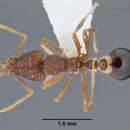en
names in breadcrumbs


biolleyi occurs in wet forest habitats. It nests on the forest floor, in dead wood, rotten twigs, and under loose bark. Workers forage nocturnally.
Southern Mexico (Chiapas) to Ecuador, Jamaica. In Costa Rica common on the Atlantic slope and montane areas to 1600m; appears absent from lower Pacific slopes.
Taxonomic history
Brown, 1953f: 103 (q.); Wheeler & Wheeler, 1960b PDF: 26 (l.).Senior synonym of Strumigenys luctuosa: Brown, 1953f: 101.Senior synonym of Strumigenys tridens: Brown, 1953f: 101.See also: Bolton, 2000: 530.